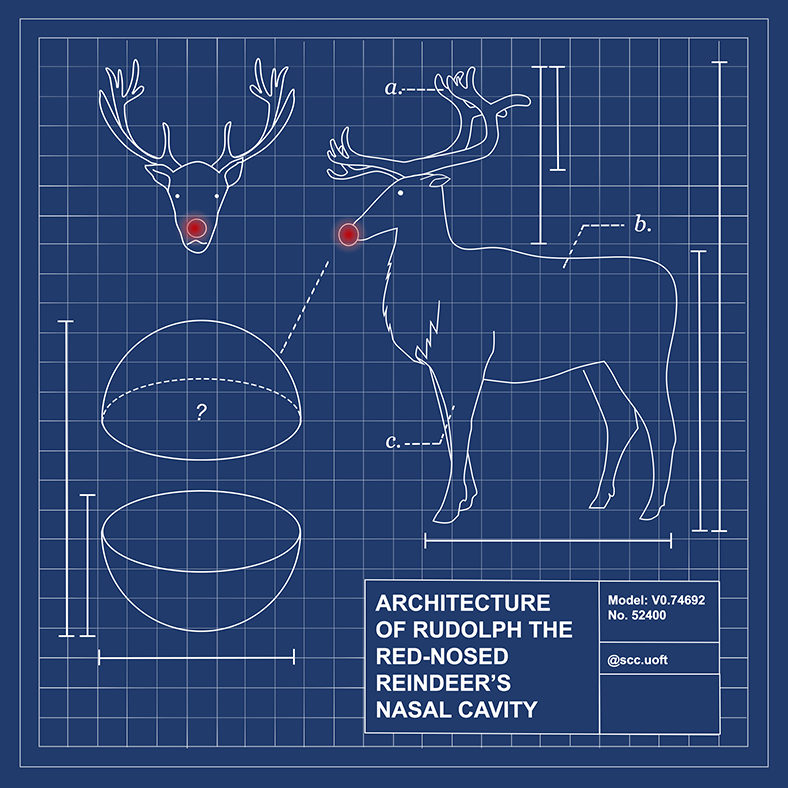
Written by Melissa Wong
Illustrated by Sally Kyunga Kim
“Rudolph the Red-Nosed Reindeer / Had a very shiny nose / And if you ever saw it / You would even say it glows.” It’s almost that time of the year again when Santa travels around the world delivering presents to children on his Nice List. On Christmas Eve, nine reindeers are responsible for pulling Santa’s sleigh. And if we recall, “the most famous reindeer of all” (aka Rudolph) possesses a bright red nose that guides Santa on his travel. Why is Rudolph the only reindeer with a shiny nose? How did Rudolph even acquire a glowing nose? Perhaps some science can explain this phenomenon!
A scientific theory, proposed by a biologist at Johns Hopkins, suggests that horizontal gene transfer is responsible for Rudolph’s glowing nose. Horizontal gene transfer is the transfer of genetic information between organisms, rather than from parent to offspring. The scientist noted that there are many fluorescent and bioluminescent (aka light-producing) organisms on Earth. And due to chance, there might have been an exchange of genetic material from these naturally fluorescing organisms to Rudolph. The biologist also noted that Anthozoan corals display bright red colours. He then came up with a possible (but not very probable) scenario of a female reindeer, pregnant with Rudolph, travelling to the tropics all the way from the North Pole!
For horizontal gene transfer to occur, Rudolph’s mom first gets infected with Anthozoan coral DNA by accidentally scratching herself while admiring the corals. Although highly unlikely, the DNA finds its way to fetus Rudolph and is incorporated into Rudolph’s genetic material. Specifically, the Anthozoan coral DNA is inserted into a gene that makes proteins in the nose. As a result, Rudolph’s nose is able to fluoresce a red colour like the Anthozoan coral!
In addition to the theory, studies have been conducted to try to understand the science behind the red nose. The second explanation is based on the physiology of the reindeer’s nose. The vascular system of the reindeer’s nasal cavity is very dense–it has been reported to be 25% more dense than that of humans. Having a rich supply of blood vessels allows reindeers to regulate their internal temperatures. Reindeers have extremely insulating fur coats and are oftentimes faced with overheating. To overcome this overheating, blood is pumped to the nose for heat to be released. This may be a plausible explanation for Rudolph’s red nose as he covers a lot of distance on Christmas Eve!
Reindeers also have a special feature in their noses–heat exchangers–that help regulate their internal temperatures. To conserve heat, reindeers first cool the air with their heat exchangers before breathing out the air. This way they don’t lose heat!
Although the reindeers’ noses turn red when overheated, they probably do not glow “like a lightbulb.” The scientific theory seems to be a better explanation for Rudolph as a red fluorescing nose is more likely to have guided Santa’s sleigh that “one foggy Christmas Eve!”
Sources:
- https://releases.jhu.edu/2017/12/04/johns-hopkins-scientists-explain-rudolph-grinch-scrooge/
- https://www.ncbi.nlm.nih.gov/pmc/articles/PMC4536854/
- https://www.britannica.com/animal/reindeer
- https://www.nationalgeographic.org/encyclopedia/tropics/
- http://www.bbc.com/earth/story/20151209-why-reindeer-noses-are-more-amazing-than-you-think
- https://emj.bmj.com/content/24/12/848.2
- https://www.jstor.org/stable/23493377